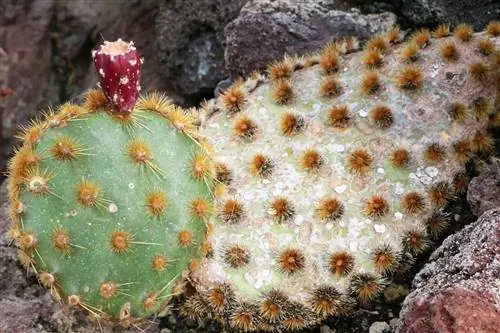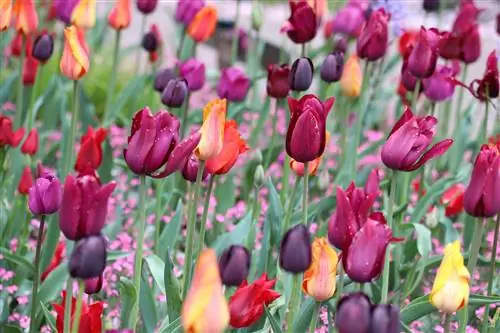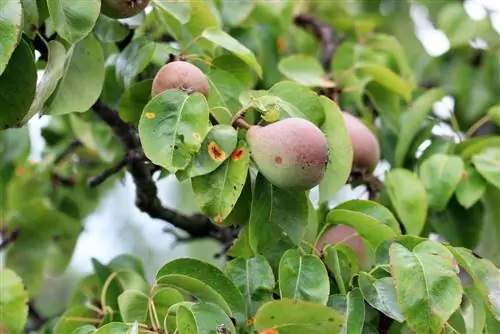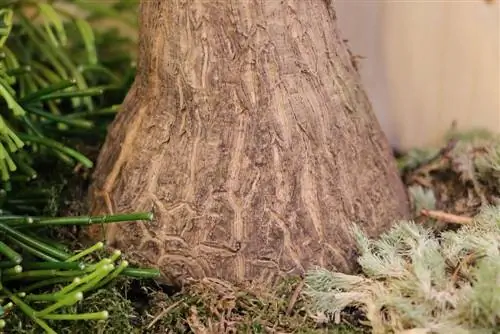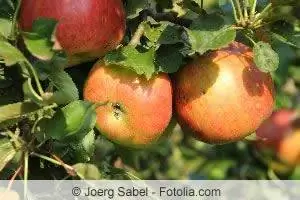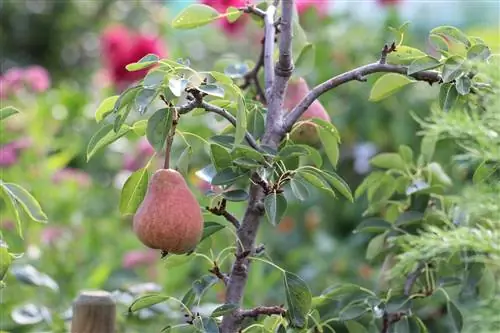- Author admin [email protected].
- Public 2023-12-17 03:39.
- Last modified 2025-06-01 06:48.
The prickly pear cactus is not only a beautiful plant on the windowsill, but also an extremely delicious source of fruit. With proper care, which is not at all time-consuming, the exotic plants produce prickly pears - which are something for the eyes and the taste buds.
If you want to cultivate not only a decorative plant, but also an unusual and he althy source of fruit, the prickly pear is the best choice. Because many opuntias, as the varieties of prickly pear are also called, offer both. The plants don't expect much. Even beginners in plant care can quickly achieve success with them. As frugal as the prickly pear is, it does not forgive some care mistakes. In order to thrive and have a rich harvest, there are a few things you need to keep in mind.
Location
The prickly pear cactus needs a lot of sun to thrive and produce fruit. The more light the opuntia gets, the better. It doesn't matter whether the plant is on the windowsill, the balcony or in the garden. In addition, the Opuntia's location must be somewhat sheltered because it cannot tolerate strong, cold winds or excessive rain. It should be noted that the prickly pear cactus can only withstand short periods of frost - but it will be damaged if the temperatures continue to be cold. Separate winter storage is therefore required.
Substrate
The prickly pear cactus requires a comparatively nutrient-poor substrate that is also dry and loose. A mixture of: is well suited
- Planting soil or mature compost
- Coconut fiber or peat
- Sand
- gravel or perlite
The soil can be stony, so even a mixture of equal parts of the ingredients mentioned is possible without any problems.
Pouring
The prickly pear prefers to be dry, so some time can and should pass between waterings. It is ideal if the top layer of the substrate is well dried. If the opuntia is free in the garden, rainfall is usually sufficient. The time of fruit formation is the exception here. During this phase - which falls in late summer - sufficient fluids are crucial. If there is no rain, the garden must also be watered. Fresh and stale tap water or rainwater can be used for watering.
Fertilize
As frugal as the prickly pear cactus is, it usually doesn't need any fertilizer when planted in fresh substrate. If it has been in the pot for a while, it can be supplied with cactus fertilizer from spring to late summer. Potassium-accentuated agents in liquid form, which are administered every two weeks, are optimal.
Blend
The Opuntia does not require any topiary. Only discolored plant parts should be cut off. In addition to its fruits, the prickly pear also offers edible leaves that can be prepared as a vegetable. These can also be harvested by cutting them.
Tip:
Sturdy gloves should be worn when cutting, as the thorns are barbed and therefore difficult to remove from the skin.
Repotting
Annual repotting is not absolutely necessary, but it saves swell and also reduces the risk of disease and pest infestation. The new pot should only be slightly larger than the previous one. Otherwise, only root growth will initially be stimulated. Again, gloves should be worn to protect yourself from the stingers.
Harvest
If fruits have formed on edible varieties and have turned reddish, the harvest will take some time to arrive. The prickly pears are only ripe when they give in under light pressure. Depending on the exact species, this usually occurs in late summer, around August or September. Other varieties are not ready until autumn. To harvest, the fruiting bodies are again broken off or cut off with light pressure. The figs can be cut open and scooped out or peeled.
Tip:
A particularly recommended species is the Opuntia ficus indica, which bears very tasty fruits.
Propagation
Opuntias are propagated via seeds contained in the fruits. Sown on peat and only lightly covered, they germinate quite quickly. It usually only takes about two weeks for the first shoots to sprout. Propagation through a so-called cactus ear is also possible. To do this, a fleshy, green leaf of the prickly pear is cut off and halved. The resulting pieces are then pressed down into the substrate with an interface. But only a finger's width, otherwise there is a risk of mold. For better support, the pieces can also be stood up with rods. By watering small amounts regularly, roots will form quite quickly. After just two to three weeks, development can be noticed with a slight pull on the plant. If it is stuck, there are roots and the rods can be removed.
Wintering
If the temperatures drop to around 10 °C, the opuntias must be brought indoors. Their ideal winter quarters are bright and unheated. A temperature between 6 and 10 °C is optimal. Apart from these demands, the prickly pear cactus is once again frugal. It just needs sparing watering at long intervals to prevent it from drying out completely.
Typical pests and diseases
The prickly pear cactus is not susceptible to diseases. Rot can only occur if the crop is watered too heavily or if the culture is too moist overall. Pests are also rare and are usually only found in the winter quarters when they are too dry and warm. Below:
- Scale insects
- Mealybugs
- Spider mites
- mealybugs
If the humidity is increased briefly, for example by spraying and sealing the plant airtight, the pests will disappear again. In the case of stubborn infestations, the use of natural predators such as ladybirds, lacewings and parasitic wasps is effective. If this control is not possible, yellow plates and insecticides can help.
Frequently asked questions
Are all prickly pear cactus edible?
Not all prickly pears are the same, so among the varieties there are also purely decorative variants that are not edible. Of course, this is something to keep in mind when making your selection.
Why do the fruits stay small?
If the prickly pears remain very small and the overall harvest is sparse, the opuntia usually lacks the necessary water at the right time. As soon as flowers form, the amount and frequency of watering can be increased if necessary. Changing to fresh substrate or additional fertilization can also increase the yield.
What you should know about the prickly pear cactus in brief
- The prickly pear belongs to the cactus family.
- The genus Opuntia has around 400 species. Most Opuntia fruits are edible and tasty.
- The prickly pear cactus is generally cultivated as a houseplant, but there are also hardy varieties.
- Opuntias prefer a bright, full-sun location (south windows are ideal), if possible outdoors in summer.
If the prickly pear cactus spends the summer outside, it needs to be kept in a cool place in the winter and you should also stop watering almost completely (a little bit of water once a month). Overwintering can take place in light conditions at a temperature of 4-10 °C. The cool and almost dry wintering promotes flowering in summer. Care during the growing season (May - August) is very easy. Water moderately and provide cactus fertilizer weekly. Dry periods are tolerated better than stagnant moisture. Propagation is also quite easy. Broken or cut ears root easily. However, the breaking point or the cut surface must dry for approx. 14 days before planting. Cactus soil is preferred as a substrate.
Opuntias
Some species of Opuntia adorn themselves with red or pink flowers in summer. Opuntias have large, hard thorns and stubborn glochids. While the spines are relatively easy to remove, the glochids have small barbs that make removal from the skin difficult. It is therefore advisable to only handle opuntias with sturdy gloves. If something happens, you can drip liquid candle wax onto the areas and carefully remove the thorns with the help of tweezers.
Winter-hardy varieties are better bought from specialist retailers, but are not quite as inexpensive as their non-hardy counterparts. Hardy opuntias look pitiful outside in winter and you would think they were frozen to pieces. But with the first rays of sunshine they begin to recover. Stony, permeable soils are preferred where no waterlogging can occur, even during prolonged rain.

